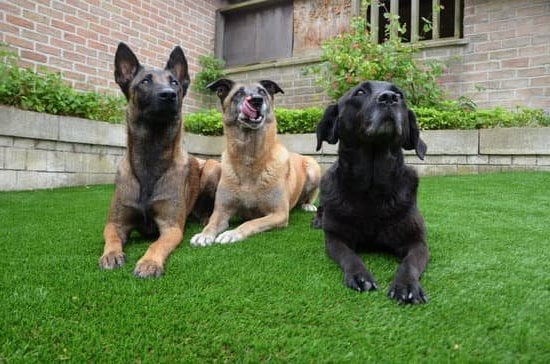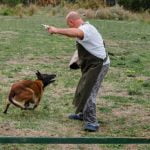Fearfulness in dogs can greatly impact their quality of life and overall well-being. In order to help your furry friend overcome their fears, it is important to understand the importance of addressing fearfulness in dogs. By taking the necessary steps to train and support your dog, you can help them lead a more confident and fearless life.
Fear in dogs can stem from a variety of causes, such as past traumas, lack of socialization, or genetic predispositions. Recognizing these triggers and understanding their impact on your dog’s emotions is crucial in helping them overcome their fears. This article will provide valuable insights into common causes of fearfulness in dogs, allowing you to identify the triggers that affect your furry friend.
Recognizing the signs of fear in dogs is essential for effective training. Behavioral indicators such as trembling, hiding, excessive barking or aggression are all indications that your dog may be experiencing fear. By learning how to decipher these signs, you can better understand your dog’s emotional state and tailor your training techniques accordingly.
Building trust and a strong bond with your dog is key to establishing a solid foundation for fearlessness training. Dogs who trust their owners are more likely to feel secure and safe when facing fearful stimuli. This section will explore different strategies for bonding with your canine companion and nurturing a relationship built on trust and understanding.
By familiarizing yourself with these foundational concepts, you can begin the journey towards helping your beloved canine companion conquer their fears. With patience, consistency, and positive reinforcement techniques discussed later in this article, you can instill confidence in your dog and improve their overall well-being. Together, let us explore the world of fearlessness training for dogs, empowering both pets and owners alike.
Common Causes of Fearfulness in Dogs
Many dogs experience fearfulness at some point in their lives, and it is important for dog owners to understand the common causes of fear in order to address and alleviate their furry friend’s anxieties. By identifying the triggers that lead to fearfulness, owners can take proactive steps to help their dogs overcome these fears and live happier, more confident lives.
Early Traumatic Experiences
One common cause of fearfulness in dogs is early traumatic experiences. Puppies who have experienced abuse or neglect during their critical socialization period may develop deep-seated fears and anxiety. Similarly, a traumatic event such as being attacked by another dog or being involved in a car accident can also trigger fear responses in dogs. Identifying these early traumas can help dog owners better understand the root causes of their pet’s fearfulness.
Lack of Socialization
Dogs that have not been properly socialized during their formative years are more prone to developing fears and anxieties. When puppies do not have exposure to various people, animals, environments, and objects, they may become overwhelmed and fearful when faced with new experiences later in life. It is crucial for dog owners to provide ample opportunities for their puppies to interact with different stimuli from an early age.
Genetic Factors
Some dogs may be genetically predisposed to developing fearful behaviors due to breed-specific traits or genetic factors that affect temperament. Breeds that were historically bred for guarding or protection purposes may exhibit heightened fear responses. Understanding the breed characteristics and potential genetic factors can help dog owners anticipate possible triggers for fearfulness.
By identifying the common causes of fearfulness in dogs, owners can begin to address these issues with targeted training techniques and create a safe environment for their pets. It is important to remember that each individual dog is unique, so what triggers fear in one dog may not affect another. With patience, consistency, and a solid understanding of the triggers, owners can help their dogs overcome their fears and build confidence in various situations.
Recognizing the Signs of Fear in Dogs
When it comes to training dogs not to be fearful, one of the first steps is to recognize the signs of fear in your furry friend. By understanding the behavioral indicators of fear, you will be able to better address and manage your dog’s anxiety. Here are some common behavioral indicators that may suggest your dog is feeling fearful:
- Body Language: Pay close attention to your dog’s body language as it can provide valuable insights into their emotional state. Common signs of fear include trembling or shaking, tucked tail, lowered body posture, cowering or hiding, and averted gaze.
- Vocalizations: Dogs may express fear through various vocalizations. They may whimper, whine, growl, bark excessively, or even yelp when they encounter something that triggers their fear response.
- Escape Behaviors: Fearful dogs often try to escape from the situation or stimuli that is causing them distress. This can manifest as pulling on the leash to retreat, attempting to flee or hide behind objects or under furniture, or trying to escape from their crate.
- Aggression: Fear can sometimes trigger aggression in dogs as a means of self-defense. This aggression can range from growling and snarling to biting if the dog feels cornered or threatened.
Understanding these behavioral indicators is crucial for two reasons
Firstly, by recognizing these signs early on, you can intervene and provide support before your dog’s fear escalates further. Secondly, understanding your dog’s specific behavioral indicators will help you tailor your training approach accordingly. For example, if your dog shows signs of avoidance behavior such as hiding or trying to escape when faced with fearful stimuli, desensitization and counterconditioning techniques may be most effective.
It is important to note that every dog is unique and may display different behavioral indicators of fearfulness. Therefore, it is essential to observe and understand your individual dog’s specific body language and vocalizations to accurately assess their fear levels. By being attentive to these behavioral indicators, you’ll be more equipped to address your dog’s fears effectively and help them become more confident and comfortable in various situations.
In summary, recognizing the signs of fear in dogs is crucial for successfully training them to overcome their fearfulness. Pay close attention to your dog’s body language, vocalizations, escape behaviors, and potential aggression.
Understanding your dog’s unique behavioral indicators will enable you to tailor your training approach and provide the necessary support they need. By recognizing and addressing fear in a timely manner, you can help instill confidence and set your beloved canine companion on a path towards a fearless life.
Building Trust and Bond with Your Dog
Building a strong foundation of trust and bond with your dog is crucial when addressing fearfulness. By establishing a solid relationship based on mutual respect and clear communication, you can help your dog feel safe and secure, which is essential for overcoming their fears. Here are some key strategies to consider when building trust and bond with your dog:
- Socialization: Properly socializing your dog from a young age is vital in preventing fearfulness. Expose them to different environments, people, animals, and sounds in a positive and controlled manner. This will help them become familiar with new stimuli and reduce the likelihood of developing fearful responses later on.
- Consistency: Dogs thrive on routine and consistency, so it’s important to establish clear rules and boundaries that you consistently adhere to. This provides them with a sense of structure and predictability, which can help alleviate anxiety and foster trust.
- Positive reinforcement: Positive reinforcement techniques such as praise, treats, toys, or playtime can be incredibly effective in building trust with your dog. Reward them for good behavior, obedience, or any small signs of progress they make towards overcoming their fears. This will strengthen the bond between you and create positive associations with training sessions.
- Avoid punishment: Punishment-based training methods can erode trust and increase fearfulness in dogs. Avoid using physical force or yelling as these techniques can lead to more fearful behaviors. Instead, focus on redirecting their attention away from fear-inducing stimuli towards more positive experiences.
- Spend quality time together: Regularly spend one-on-one time engaging in activities that your dog enjoys such as walking, playing fetch, or simply relaxing together. This quality time not only solidifies your bond but also helps build your dog’s confidence by showing them that they can rely on you for support.
By implementing these strategies consistently over time, you can establish a strong foundation of trust with your dog. This will create an environment in which they feel safe and secure, setting the stage for successful fearfulness training. Remember that building trust takes time and patience, so be sure to celebrate each small step forward with your furry companion.
Positive Reinforcement Training Techniques
Positive reinforcement training techniques are a powerful tool in helping dogs overcome their fearfulness and develop positive associations with previously fearful stimuli. By rewarding desirable behaviors and creating a positive learning experience, you can effectively shape your dog’s responses and build their confidence.
Understanding Positive Reinforcement
Positive reinforcement involves providing rewards whenever your dog exhibits a desired behavior. This can be in the form of treats, praise, toys, or any other reward that your dog finds motivating. The key is to immediately reward your dog as soon as they display the desired behavior, reinforcing the connection between the behavior and the reward.
Capturing Calmness
One effective technique using positive reinforcement is to “capture calmness.” At times when your dog is relaxed and not exhibiting signs of fear or anxiety, reward them with praise or treats. By doing this consistently, you are teaching your dog that being calm is a desirable behavior. Over time, they will start associating calmness with positivity.
Counterconditioning Fearful Stimuli
Counterconditioning is another positive reinforcement technique that can be used to help dogs overcome their fears. It involves gradually exposing your dog to the fearful stimulus while simultaneously providing rewards and positive experiences. For example, if your dog is afraid of loud noises like thunderstorms or fireworks, you can create a safe space for them during these events and offer treats or playtime to distract them from their fear.
Clicker Training
Clicker training is another popular positive reinforcement technique that can be used to train dogs who are fearful. The clicker serves as a distinct sound marker that signals to the dog that they have performed the desired behavior correctly and a reward is forthcoming. With repetition and consistency, dogs learn to associate the clicker sound with positive rewards, creating a positive association with training sessions and reducing fearfulness.
It’s important to note that positive reinforcement training techniques should be used in conjunction with other methods, such as desensitization and counterconditioning. By combining these techniques and customizing them to your dog’s individual needs, you can greatly improve their fearfulness and build their confidence over time.
Gradual Exposure to Fearful Stimuli
Desensitization and counterconditioning are two highly effective techniques that can be used to help dogs overcome their fearfulness. By gradually exposing the dog to the fearful stimuli in a controlled and positive way, we can teach them to associate these triggers with something enjoyable or neutral, rather than fear or anxiety. This section will provide a step-by-step guide on how to implement desensitization and counterconditioning techniques with your fearful dog.
- Start by identifying the specific trigger that causes fear in your dog. It could be anything from loud noises to certain objects or people. Once you have identified the trigger, create a hierarchy of exposure levels for your dog. For example, if it’s thunderstorms that scare your dog, you can start by playing recordings of distant thunder at a low volume.
- Begin the desensitization process by introducing the trigger at the lowest level of intensity that does not evoke fear or anxiety in your dog. This could involve showing them pictures of the trigger or playing sounds associated with it. Gradually increase the intensity over time as your dog becomes more comfortable.
- While exposing your dog to the trigger, it’s important to create a positive association with it through counterconditioning. This involves pairing the presence of the trigger with something that your dog loves, such as treats or playtime. For example, whenever you play thunderstorm sounds, give your dog a special treat or engage in their favorite game.
- Repeat this process consistently and gradually increase exposure levels as your dog becomes more comfortable and starts associating the trigger with positive experiences. It’s crucial to go at a pace that is appropriate for your individual dog – some may progress quickly while others may need more time.
- Remember to always reward and praise your dog for their brave behavior during each desensitization session. Positive reinforcement will help build their confidence and reinforce their new positive associations with previously fearful stimuli.
By following these steps and being patient and consistent, desensitization and counterconditioning can help your dog overcome their fearfulness and develop a more positive outlook on the triggers that once caused them anxiety. It’s important to note that every dog is different, so it may be beneficial to consult with a professional dog trainer or behaviorist for guidance tailored to your specific situation.
With time, effort, and the right approach, you can help your beloved canine companion feel more confident and fearless in the face of their fears.
Implementing Desensitization and Counterconditioning
Desensitization and counterconditioning are effective techniques for helping fearful dogs overcome their fears and develop positive associations with previously triggering stimuli. By gradually exposing the dog to these stimuli in a controlled and positive manner, we can help them build confidence and reduce anxiety. Here is a step-by-step guide on how to implement desensitization and counterconditioning:
- Identify the trigger: The first step is to identify what triggers your dog’s fear response. It could be anything from loud noises to specific objects or situations. Once you have identified the trigger, you can start working on developing a plan.
- Start with baby steps: It’s important to start the desensitization and counterconditioning process gradually. Begin by introducing your dog to the trigger at a distance where they feel comfortable and relaxed. It could be as simple as showing them the object or playing a recording of the sound at a low volume.
- Monitor your dog’s reaction: Pay close attention to your dog’s body language during each exposure. Look for signs of fear or anxiety such as trembling, panting, or trying to escape. If you notice any signs of distress, it means you need to decrease the intensity or distance between your dog and the trigger.
- Pair the trigger with something positive: As your dog starts getting used to the presence of the trigger, it’s time to associate it with something positive. Give your dog treats, praise, or playtime whenever they encounter the trigger, creating a positive association in their minds.
- Gradually increase exposure: Over time, begin increasing the intensity or proximity of the trigger while still providing positive reinforcement for calm behavior. Keep increasing exposure levels gradually so that your dog can build confidence without feeling overwhelmed.
- Be patient and consistent: Desensitization and counterconditioning take time and patience. It is essential to be consistent in your training efforts and stick to the plan. Each dog progresses at their own pace, so don’t rush the process.
Remember that desensitization and counterconditioning should always be done under the guidance of a professional if you are unsure or if your dog’s fearfulness is severe. With dedication and a well-executed plan, these techniques can help your beloved canine companion overcome their fears and live a happy, fearless life.
Seeking Professional Help
Training a fearful dog can be a challenging and complex process. While some dog owners may be able to address their dog’s fearfulness on their own, there are cases where enlisting the assistance of a professional dog trainer or behaviorist is necessary. These experts have the knowledge and experience to provide specialized guidance and support to help your dog overcome their fears.
So, when should you seek professional help for your fearful dog? One important factor to consider is the severity of your dog’s fear. If your dog exhibits extreme fear reactions, such as excessive panting, trembling, cowering, or aggression in response to triggers, it is crucial to involve a professional. A qualified trainer or behaviorist can accurately assess your dog’s behavior and determine the appropriate course of action.
Another situation that may warrant seeking professional help is if you have tried various training techniques and methods without success. Sometimes, we may unintentionally reinforce our dog’s fears or unknowingly use ineffective training approaches. A professional can offer fresh insights, identify possible mistakes in previous training attempts, and provide valuable guidance on more effective methods tailored specifically to your dog’s needs.
It is also essential to consider seeking help from a professional if you lack experience in working with fearful dogs. Training a fearful dog requires patience, dedication, and a deep understanding of canine behavior and psychology. A professional trainer or behaviorist has undergone extensive education and training in these areas and can provide expert advice on how to properly train your fearful dog without exacerbating their fears.
By involving a professional in your dog’s fear-based training journey, you are not only ensuring that your beloved companion receives top-notch care but also increasing the chances of overcoming their fears successfully. With their expertise and guidance, you can create a customized training plan that addresses your specific concerns and helps your dog build confidence and resilience.
| Signs It’s Time to Seek Professional Help: |
|---|
| – Extreme fear reactions: Excessive panting, trembling, cowering, or aggression. |
| – Ineffective previous training attempts. |
| – Lack of experience in working with fearful dogs. |
Creating a Safe and Supportive Environment
Creating a safe and supportive environment is crucial when it comes to training a fearful dog. By minimizing stress and anxiety, you can help your dog feel more secure and confident in their surroundings. Here are some strategies to create an environment that promotes calmness and reduces fearfulness in dogs.
Firstly, it’s important to establish a routine for your dog. Dogs thrive on structure and predictability, so having consistent daily routines can help them feel more secure. This includes regular feeding times, exercise schedules, and designated sleeping areas. By providing a predictable routine, you can reduce your dog’s anxiety and give them a sense of control over their environment.
In addition to establishing a routine, you should also ensure that your dog has a comfortable and safe space of their own. This could be a crate or a designated area in the house where they can retreat to when they need some alone time. Make sure this space is equipped with cozy bedding, toys, and treats to further enhance their sense of security.
Another important aspect of creating a safe environment is managing your dog’s exposure to potential triggers of fear. For example, if your dog is fearful of loud noises such as thunderstorms or fireworks, provide them with a safe haven where they can retreat during these events. This could be a soundproofed room or using white noise or calming music to drown out the sounds.
Lastly, consider using calming aids such as pheromone diffusers or natural supplements that promote relaxation in dogs. These products can help reduce anxiety levels and create an overall calming effect in the environment.
By creating an environment that is free from stressors and provides comfort and security for your dog, you can help minimize their fearfulness and set the stage for successful training. Remember that patience and consistency are key when working with fearful dogs, so continue to build trust with your canine companion throughout the training process.
Consistency and Patience
When it comes to training a dog not to be fearful, consistency and patience are essential. Consistency in your approach and actions will help your dog understand what is expected of them, while patience will allow them the time they need to overcome their fears. In this section, we will explore why these two qualities are crucial for successful fearfulness training and provide some tips on how to incorporate them into your training program.
Consistency is vital because dogs thrive on routine and clear expectations. By being consistent in how you respond to your dog’s fears, you can help them understand that there is nothing to be afraid of or that they can trust you in challenging situations. For example, if your dog is afraid of loud noises such as thunderstorms or fireworks, consistently providing a safe space for them during these events and offering comforting reassurance will help them feel more secure.
In addition to consistency, patience is equally important when addressing fearfulness in dogs. It’s essential to remember that overcoming fear takes time and effort. Pushing your dog too quickly or getting frustrated with their progress can hinder their learning process and cause further anxiety. Take small steps with your dog’s training and give them plenty of opportunities to practice being calm and confident in gradually increasing levels of fearful stimuli.
To effectively incorporate consistency and patience into your fearfulness training program, consider the following tips:
- Stick to a regular schedule: Establish a consistent routine for your dog’s training sessions. This will help create structure and predictability, which can be calming for a fearful canine.
- Use positive reinforcement: Focus on rewarding desired behaviors rather than punishing unwanted ones. Positive reinforcement encourages your dog’s confidence while building a positive association with the situation or stimulus they previously feared.
- Set realistic expectations: Understand that progress may be slow at times, but each small step forward should be celebrated. Be patient with your dog and trust the process.
| Tips to Incorporate Consistency and Patience |
|---|
| Stick to a regular schedule |
| Use positive reinforcement |
| Set realistic expectations |
By being consistent and patient in your fearfulness training, you are setting the stage for success. Remember that every dog is unique, and progress may vary. With time, dedication, and a supportive approach, you can help your beloved canine companion overcome their fears and build confidence in themselves and in you as their caregiver.
Overcoming Fearfulness in Specific Situations
One of the challenges that dog owners may face is helping their dogs overcome fearfulness in specific situations such as thunderstorms, fireworks, and vet visits. These situations can be particularly stressful for dogs due to loud noises, unfamiliar environments, and potential discomfort. However, with some patience and proper training techniques, it is possible to help your dog feel more confident and less fearful in these situations.
Thunderstorms often trigger fear in dogs due to the loud thunderclaps and flashes of lightning. To help your dog overcome this fear, it is important to create a safe space for them during storms. This could be a designated area in your home where your dog feels safe and comfortable.
Provide soothing music or white noise to drown out the sound of thunder. Gradual exposure to storm sounds through recordings can also help desensitize your dog over time. Additionally, offering positive reinforcement such as treats or praise when your dog remains calm during a storm can reinforce positive associations.
Fireworks are another common fear-inducing situation for many dogs. The sudden loud noises and bright lights can cause distress and anxiety. It is crucial to keep your dog indoors during fireworks displays to prevent them from running away in fear or getting injured. Creating a calming environment by closing curtains or blinds to minimize visual stimulation can help reduce their anxiety. Similarly to thunderstorms, use positive reinforcement techniques like treats and praise when your dog remains calm during fireworks.
Vet visits can be a source of anxiety for many dogs due to the unfamiliar smells, sights, and experiences associated with the veterinary clinic. To help your dog overcome this fear, start by desensitizing them to the veterinary environment gradually.
Bring them on short visits just for simple procedures like weighing or getting their nails trimmed before moving on to more involved appointments like vaccinations or check-ups. Pairing vet visits with positive experiences like treats or playtime can create positive associations with the clinic.
Taking these steps can go a long way in helping your dog overcome their fearfulness in these specific situations. However, it is important to remember that every dog is unique and may require different approaches and timelines for improvement. Patience, consistency, and a supportive environment will be key to helping your furry friend become more confident and fear-free.
| Fearful Situation | Techniques |
|---|---|
| Thunderstorms | – Create a safe space indoors
|
| Fireworks | – Keep the dog indoors during displays
|
| Vet visits | – Desensitize gradually by bringing the dog on short visits
|
Conclusion
In conclusion, addressing fearfulness in dogs is crucial for their overall well-being and quality of life. By understanding the common causes of fear and recognizing the signs of fear in our canine companions, we can begin to build trust and establish a solid foundation for training. Positive reinforcement techniques, such as shaping positive associations, are effective in helping dogs overcome their fears.
Gradual exposure to fearful stimuli through desensitization and counterconditioning is another important step in training a dog not to be fearful. By following a step-by-step guide and implementing these techniques carefully, we can help our dogs develop confidence and replace their fear with positive emotions and experiences.
However, it is important to recognize that some cases of fearfulness may require professional help from a dog trainer or behaviorist. Seeking assistance when needed ensures that the training process is both safe and effective for both the dog and their owner.
Creating a safe and supportive environment for our dogs is also key in minimizing stress and anxiety. By providing consistent guidance, patience, and love, we can empower our beloved canine companions to overcome their fears and become more fearless individuals.
Lastly, it is essential to address specific situations where dogs may exhibit fearfulness, such as thunderstorms, fireworks, or vet visits. With proper training techniques and understanding of each individual situation, we can gradually help our dogs feel more at ease during these challenging moments.
By following these strategies consistently and displaying patience throughout the training process, we have the power to instill confidence and fearlessness in our beloved canine companions. Remember that every dog is unique, so it is important to tailor the training approach to meet their individual needs. Together, we can create a happier life for our furry friends free from unnecessary fear and anxiety.
Frequently Asked Questions
Can a fearful dog be trained?
Yes, a fearful dog can absolutely be trained. While fear can present challenges during the training process, it is not an impossible hurdle to overcome.
Patience, consistency, and positive reinforcement are key components in training a fearful dog. By using reward-based training methods and gradually introducing the dog to situations that trigger fear in a controlled and supportive manner, it is possible to build their confidence over time.
How do you train a dog to overcome fear?
Training a dog to overcome fear requires a gentle and patient approach. The first step is to identify what specifically triggers fear in the dog and then create a plan that gradually exposes them to these triggers in a safe and positive way. This process is known as desensitization and counterconditioning.
Essentially, it involves associating the feared stimulus with something positive like treats or praise, gradually increasing their exposure to it while ensuring they remain calm throughout the process. It’s important to go at the dog’s pace, celebrating small successes along the way.
Can a nervous dog be cured?
While complete “cure” may not always be guaranteed, significant improvement can often be achieved with nervous dogs through proper training and management techniques. The goal is typically focused on helping the dog develop coping mechanisms and reducing their anxiety levels rather than eliminating nervousness entirely.
This can be achieved by creating a predictable routine for the dog, establishing clear boundaries, providing plenty of mental and physical stimulation, and utilizing relaxation techniques such as massage or calming aids if necessary. Consistency and patience are crucial when working with nervous dogs since progress may take time but can ultimately lead to a happier and more confident companion.

Welcome to the blog! I am a professional dog trainer and have been working with dogs for many years. In this blog, I will be discussing various topics related to dog training, including tips, tricks, and advice. I hope you find this information helpful and informative. Thanks for reading!





